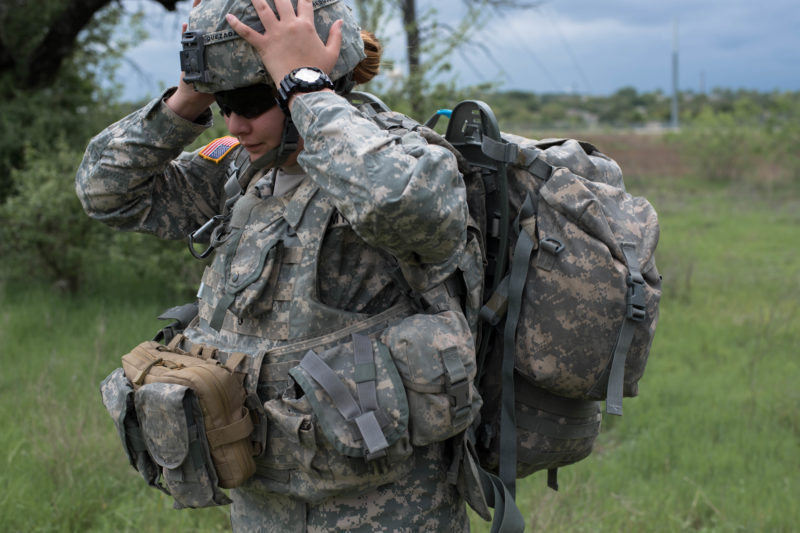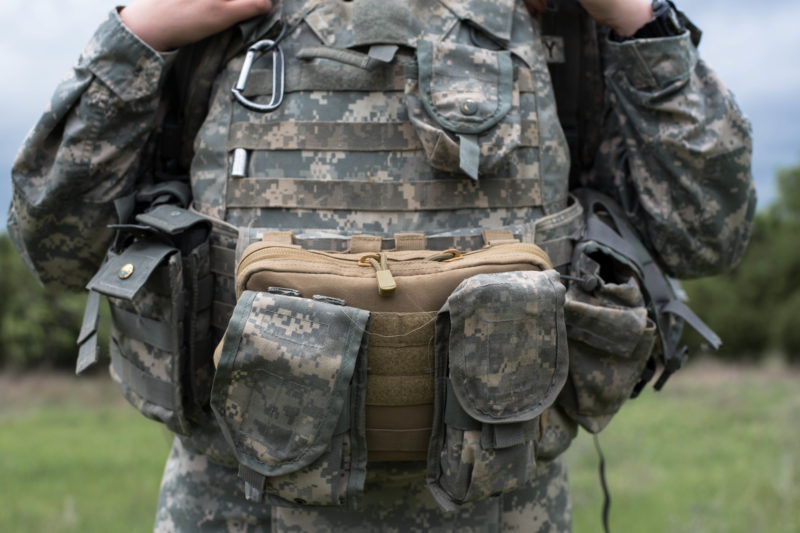Female Soldiers Face Higher Risk of Training Injuries, Study Finds
By Alexandra Paez
Photography By John Flynn
Reporting Texas

Soldiers carry a lot of weight in field training, as this woman showed at Fort Hood; officials would not allow her to be named. The weight can lead to musculoskeletal injuries for women. John Flynn/Reporting Texas
Deanna Rivera was in the Army for only a few months when she began feeling pain in her left hip.
Rigorous days of tactical training, spent wearing combat boots and a bulky vest while carrying a heavy pack of equipment and an M16 rifle, pounded her 5-foot-8, 110-pound body. Most mornings, Rivera and her fellow soldiers were required to run up to four miles.
Worse yet was the Army’s staple training event, the ruck march, which consists of carrying 35 to 50 pounds of gear over 12 miles. Rivera, like all Army soldiers, completed several ruck marches.
When the pain became too much, Rivera reported it to her superior officer and was placed on a medical profile, an altered training regimen based on a doctor’s recommendation.
The doctor at Fort Huachuca, Arizona, told her that she was putting a lot of extra pressure on her hip and advised her to “take it easy,” Rivera said. She didn’t want people to accuse her of being weak, so she pushed through the injury.
Rivera’s sister experienced similar physical problems from prolonged strenuous activity in the military.
“I think that because there are so many females [who] complain about problems with their hips, everything just gets brushed off and pushed to the side,” Deanna Rivera said. “My sister, she had stress fractures in her hips, her knees and her feet.”
When it comes to injuries like the ones Rivera and her sister sustained, there is a gender gap in the U.S. armed forces, according to medical researchers at the University of Pittsburgh, who found that female soldiers were twice as likely to have musculoskeletal injuries as were their male counterparts.
The women surveyed had a 36 percent occurrence of duty-limiting MSI (musculoskeletal injury), according to the study published in the November issue of Military Medicine, a journal of the Association of Military Surgeons of the United States. MSI is defined as injury to muscle, tendon, bone, ligament, nerve or joint that impairs a soldier from performing job tasks or physical training.
Women from three Army Brigade Combat Teams deployed to Afghanistan were subjects of the research.
“Musculoskeletal injuries are the most common reason for seeking medical care in the military while in training, garrison and deployment,” the study’s lead author, Dr. Tanja Roy, explained in an email interview.
“I was lucky to study injuries in female soldiers” to help identify the risk factors, wrote Roy. “There has already been research on male soldiers.”

Female soldiers are twice as likely as men to suffer musculoskeletal injuries due to their equipment. The military is researching new equipment to better fit different body types and prevent injury. John Flynn/ Reporting Texas
Currently, Roy is the executive officer at the Clinical Public Health and Epidemiology Directorate Army Public Health Center in Aberdeen Proving Ground, Maryland. But she was enrolled in the Army’s Long-term Health Education and Training Program at the University of Pittsburgh when she led the team of researchers.
Lifting and carrying heavy loads for long periods of time are major risk factors for MSI, and these are common tasks required in military training. Researchers say that carrying more than 10-percent of an individual’s body weight increases the chance of injury.
Based on the Army’s height and weight standards for soldiers, a woman between 21 and 27 years old who stands 5 feet 7 can weigh up to 161 pounds. Ten percent of her body weight is 16 pounds, but on a standard road march, soldiers carry a 35-pound rucksack. Out in the field, a soldier’s ruck can weigh 50 pounds.
Another risk factor: Instead of being given equipment fitted to the female body, many women in the military are forced to adapt to ill-fitting gear. Soldiers are required to wear the gear that the Army issues at initial training. Once the soldier is assigned to a unit, he or she can purchase some items, such as boots or gloves, but that is not the case for equipment such as the bulky tactical vest.
The physical challenges of deployment and tactical training do not make up the entirety of one’s military career. A musculoskeletal injury, however, can adversely affect job performance and quality of life throughout a soldier’s time in active duty. For Rivera, after two deployments wearing gear and carrying full combat loads of ammunition, injuries cut her career short by many years; she was a sergeant when she was retired.
“Now I am barred from ever going back,” she said. “It sucks.”
Her type of injury is one of the most common reasons that female veterans seek health care from Veterans Affairs, according to the U.S. Department of Veterans Affairs.
While still early, there are signs that the military is making changes to address female injuries. “Injury prevention is one of the top priorities of the Army,” Roy said. For example, the Army is improving its body armor to address concerns that it is too bulky and heavy for soldiers.
Women have had ill-fitting body armor for years. The Defense Advisory Committee on Women in the Services has been making recommendations to change Army equipment to suit the female body, as listed in its annual reports.
While testing the new equipment, women found that the Army’s new Soldier Protective System still didn’t fit quite right, as reported in the 2016 Annual Report for the Officer of the Director, Operational Test and Evaluation. The equipment restricted females, limiting upper body movement and preventing soldiers from aiming their weapons properly.
Having more sizes and styles is recommended to provide a better fit for females. Equipment testing will continue throughout 2017. Fort Hood was one of the test sites.
The new Army equipment has a lighter modular system for its tactical vest protection that covers more surface area on a soldier’s body. The 23-pound Torso and Extremity Protection is about 25-percent lighter than the previous 31-pound Improved Outer Tactical Vest. The new Pelvic Protection System is designed like a pair of shorts that are worn over the uniform to protect reproductive organs as well as certain arteries. Previously, pelvic protection focused on protecting male reproductive organs and lacked artery protection.
For veterans such as Deanna Rivera, who underwent surgery after leaving the Army, changes are coming too late. But she hopes that the military will make improvements quickly enough to protect current and future female soldiers.
In January, all jobs in the military became available to women, which will lead to greater numbers of women in combat roles.